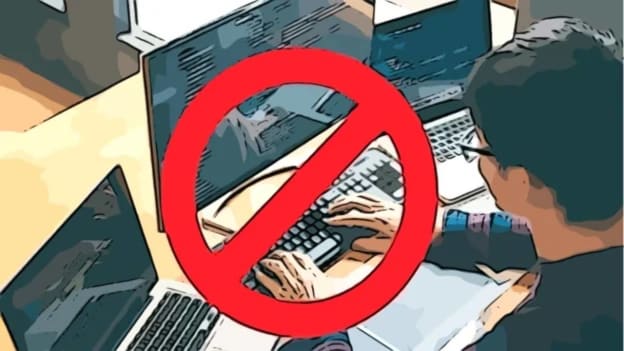How do you deal with moonlighting employees?

Moonlighting is becoming a constant irritant for companies. No firm is immune to the syndrome. This became evident when IT services giant Wipro fired 300 of its employees in September after finding out that they were working for one of its competitors at the same time. Wipro chairman Rishad Premji revealed the same in a statement and said moonlighting is a complete violation of integrity "in its deepest form".
And weeks after Wipro fired its employees for moonlighting, another Indian multinational information technology company, Infosys, laid off a few employees in recent months for moonlighting, confirmed CEO Salil Parekh.
But is firing an employee over moonlighting the right move?
Dr (HC) Guruvayurappan PV, CHRO, Omega Healthcare, says business houses are not charity houses, and every employee working in any business house is expected to abide by the appointment contract.
“Moonlighting is a menace for employers, and it is tantamount to any one or more clauses stipulated above. However, the second employment, without disturbing the existing productivity of the current job and not competing with the existing employees, may not fall under any of the above categories. Hence, such extra jobs undertaken by an employee need to be scrutinised for initiating disciplinary actions,” he adds.
The Industrial Disputes Act 1947 mandates a 30- to 90-day notice period when terminating "workmen." In the case of manufacturing units, plantations, and mines with 100 or more workmen, "termination for convenience" requires government approval; in other sectors, it requires only government notification.
However, India's labour laws cite the following reasons that justify termination for a cause—
- willful insubordination or disobedience;
- theft, fraud, or dishonesty;
- willful damage to or loss of employer’s goods;
- partaking of bribes or any illegal gratification;
- absence without leave for more than 10 days;
- habitual late attendance;
- disorderly behavior during working hours;
- or habitual negligence of work
How to deal with the intra-organisational conflict in a mutually beneficial way?
Conflicts that arise at the individual and group levels concerning the organisation's functioning are termed intra-organisational conflict. Guruvayurappan says these can be intrapersonal conflicts, where individuals' needs and desires conflict, or interpersonal conflicts, where conflicts arise between the views, desires, and needs of at least two or more individuals.
“Moonlighting can create such conflicts within the teams or between subordinates in an organisation. Recognising that moonlighting leads to potential intra-organisational conflict, companies can mitigate such conflict proactively by bringing in progressive and transparent policies on moonlighting in such a way that which type of jobs companies encourage employees to take up and which are restricted,” he says.
This way, employees working on a specific technology may take up a second job, not in line with the main job. “For example, I see a lot of ITES / BPM employees take up a second job to be delivery executives for multiple companies post their normal working hours,” he adds.
How does moonlighting relate to "brand loyalty" and workforce retention?
When an employee working in a reputed organisation ends up doing a second job in a less reputed or non-core area of employment using the company ID card, misusing his/her role in the second job with the identity of the principal employer, it can hurt the brand value of the principal employer, says Guruvayurappan.
Further, while employees work in multiple organisations, productivity dips naturally and affects the end customer experience. This will affect the brand's reputation. “When companies continue to keep such mediocre performers in the system, the superior performers in the system tend to move on due to such culture of the organisation,” says Guruvayurappan, adding that a transparent policy on moonlighting is key to address if that is observed as a trend in the organisation.
Such policies should be widely published and communicated to all employees to ensure the company doesn't take action against employees who will be taking up a second job in line with the policy. “This will further help employees feel secure to be in the organisation and enhance employee retention,” he adds.
What can the organisation do to make employees feel secure about their position in the company?
People are the main assets that support the running of activity in a company.
Guruvayurappan says people in the company are closely related to various things such as position, division of tasks, status, authority, and others. It is the main reason for frequent conflicts in an organisation.
He lists down some of the reasons for conflict within the organisation.
- The existence of weak communication
- There is enmity or envy between groups
- There is interpersonal friction
- Escalation of arbitration
- Low morale
- Existence of extreme beliefs
How to keep the workforce motivated in an environment of conflict?
Motivation has an important function in leadership, organisation, and individual members.
Guruvayurappan says one of the best ways to reduce conflict and increase motivation levels in the organisation is the function of collective leadership, organisation culture, and individuals across the organization suggesting a few tips to focus on encouraging motivation.
- Encourage organisational members to work and act; without motivation, people will not act, work, or work for themselves or the organisation.
- Increasing the efficiency level of employees and organisations. Motivated employees to carry out their work lower the cost of supervision because they do not need to be governed and supervised to carry out their routine tasks. In addition, motivated employees perform their tasks to the fullest and not only work to meet their performance standards.
- Motivation in the system increases the retention of employees. Employees with high work motivation have job satisfaction, work ethic, discipline, and high morale.











